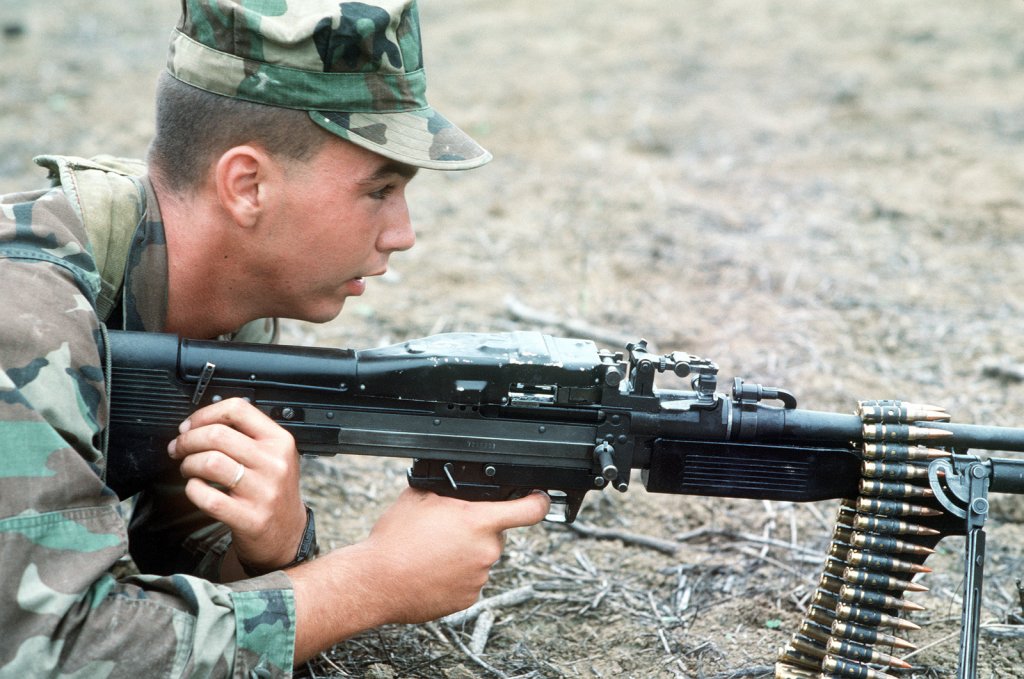World War I was known as the first war of the industrial age, with modern nations sending their best weapons to the front in massive numbers. Modern inventions like the machine gun forced changes to tactics and strategy.
America entered the war late, allowing it to pick and choose its favorite weapons from its allies while manufacturers at home tried to close America’s materiel gap. Here are seven of the machine guns America employed during the Great War:
1. Lewis Machine Gun

The Lewis Machine Gun was invented by Army Col. Isaac Newton Lewis and pitched to the service in 1911. It was turned down at the time, and a few years later the newly-retired officer showed his weapon to European buyers who were highly interested.
A factory was built in Belgium, and approximately 100,000 of the automatic weapons chambered for .30 caliber rounds saw service in World War I, including many purchased by the U.S. after its 1917 adoption of the machine gun. It could spit 500-600 rounds per minute and was especially valued in air service due to its minimal recoil.
2. Hotchkiss Model 1914

Derived from machine gun models developed in 1900 and 1897, the Hotchkiss Model 1914 was one of the most popular heavy machine guns of the war and was carried by French and U.S. troops. It was typically deployed with a tripod, though it was also used in tanks and on fortifications.
The machine gun fired up to 450 rounds per minute and was chambered for 8mm rounds. Oddly enough, the French weapon was named for an American industrialist who owned the company which manufactured it.
3. Vickers Medium Machine Gun

The water-cooled Vickers Medium Machine Gun fired rounds chambered in .303 and could spray 450 of them per minute at full speed. The Vickers did suffer from being excessively heavy for assaults at 44 pounds. But it shined in defense positions.
4. Colt-Browning M1895

Often known as the potato digger, the Colt-Browning M1895 was chambered for a range of calibers and typically weighed 22.5 pounds and fired 600 rounds per minute. A number of variants were introduced during the war, including vehicle-tank and aircraft versions manufactured by Marlin.
The American Expeditionary Forces rarely used the original infantry versions, typically opting for the aircraft version, the Marlin Gun.
5. Browning M1917 Gun

The Browning M1917 — a water-cooled, heavy machine gun — saw limited use in World War I because it was developed and manufactured late in the conflict.
It could fire .30-cal. rounds at 450-600 rounds per minute and, in one impressive test, fired over 20,000 rounds without a single malfunction.
6. Browning Automatic Rifle

The Browning Automatic Rifle, commonly known as the BAR, was developed late in the war but was rushed to the front in 1918. The air-cooled, gas-operated, magazine-fed automatic rifle commonly used in infantry assaults and counter-sniper roles. It could fire 550 rounds per minute but was typically fired in bursts.
The weapon designer’s son, 2nd Lt. John M. Browning, carried the weapon during some of his missions on the front.
7. Chauchat Light Machine Gun

The Chauchat was known for being unreliable, especially an American version re-chambered from 8mm to .308 cal. But, it was mass produced and weighed only 20 pounds allowing it to be carried by infantry on the assault.
American quality control tests on the Chauchat produced a 40-percent rejection rate.


